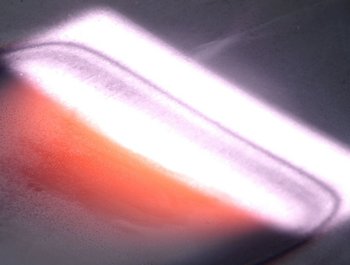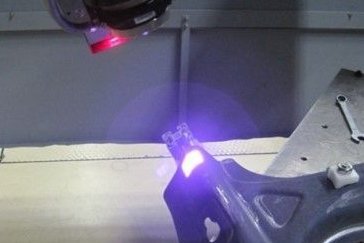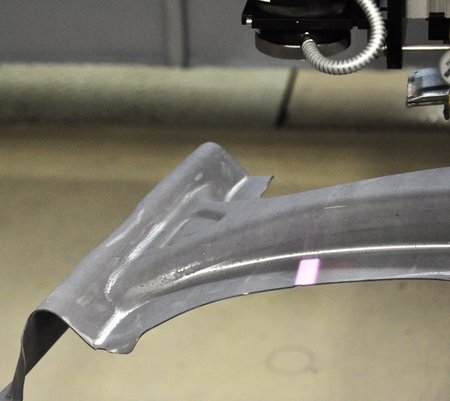Softening & Annealing Materials
Accurate heating – consistent softening across the metal’s surface – high process speed. Diode lasers are the ideal tool.
To the examplesAccurate heating – consistent softening across the metal’s surface – high process speed. Diode lasers are the ideal tool.
To the examplesSoftening is a process step for transforming steel components. During the softening process, the steel, hardened by martensite formation, is heated in locally defined areas. This changes the steel’s microstructure: depending on the temperature, the martensite is either annealed, and by extension, softened, or transformed into a more ductile, less rigid ferrite-pearlite structure via austenitization. Lasers are the best tool for this heat treatment because they guarantee flexible and high-precision treatment of material, with a small transition zone to the surrounding material affected by the heat. Neither gas flames nor infrared radiators offer a comparable process quality.
Annealing is a heat treatment that is typically applied after a hardening process. Here, too, a material is heated in order to influence its properties, in particular, to relieve tension. The higher it is tempered, the softer hardened steel becomes. This reduces its hardness and increases its toughness. In addition to traditional steel-related processes, the compensation of internal tensions within materials and components also plays a role in non-metal-related production processes, such as semiconductor production. Here, annealing processes based on diode lasers are being tested to compensate for internal tensions in wafers during the production process.
Heat treatment with diode lasers does not only enable the material to be hardened: it also does the exact opposite, namely, softening the material. Here, the solidified structure is softened in certain zones by heat exposure (“tempered”) or is, for instance, turned back into a ferrite-pearlite structure by austenitization followed by slow cooling. The result is a sheet that is easier to shape or weld. Here, the diode laser is a better tool than other methods, such as induction, gas flames or infrared rays. On the one hand, material processing can be carried out in a highly flexible and precise manner, just like with hardening; on the other hand, the transition zone created between the processed and unprocessed raw material is smaller than that created with other technologies. However, diode lasers have a very homogeneous intensity distribution, even for big spots, which makes the results of the softening especially even.
Compared to other types of lasers, Laserline's diode lasers have a bigger spot and a more homogeneous intensity distribution. Together, they both make consistent all-over softening possible. Thanks to the technology of double-sided radiation that was developed in collaboration with the Fraunhofer ILT, process speeds of more than 10 meters per minute will be a reality in the future.

Softening can actually save lives: in car body construction, soft deformation zones can be created at press-hardened areas, these zones absorb impact of energy in the event of crashes and thereby protect the body. This flexible material processing ensures that the total stiffness of the steel is maintained in the remaining zones. A further field of application is deep drawing, which sees the circuit board be softened in the intended bending zones before pressing to avoid cracks or fractures during the forming process.

In deep drawing, one of the most important industrial cold deformation processes, a metal plate is brought into the required form with the help of a rigid forming press. Fixed in a blank holder, the plate is pressed into a die with the help of a stamp and then transformed into a car panel or steel bathtub, for example. To avoid the workpiece suffering cracks or fractures during this pressing process – which is a particular risk with high-strength steels – the bending zones in question on the plate are softened beforehand. As part of this, the relevant zones are heated, with their metal structure changed as a result. Laserline’s LDM and LDF diode lasers, enable this heating to be carried out exceptionally accurately and evenly, and with high process speed.
The targeted creation of crumple zones is one of the most important safety measures in automobile construction. Crumple zones are supposed to deform in the event of an accident so that they absorb essential parts of the impact energy. To achieve this effect, the car body sheets are softened by being heated in predefined zones. Here, Laserline’s LDM and LDF diode lasers can guarantee optimum results thanks to their precise and even heat input. The metal structure is softened at exactly those points where the crumple effect is to be achieved; at all the other areas of the car body, the required firmness (which is also of relevance for safety) is maintained so that, ultimately, the vehicle occupants can enjoy maximum protection.

Which laser systems are particularly suitable for softening and annealing? You can find a selection here.
Then please feel free to contact us.
Your Request